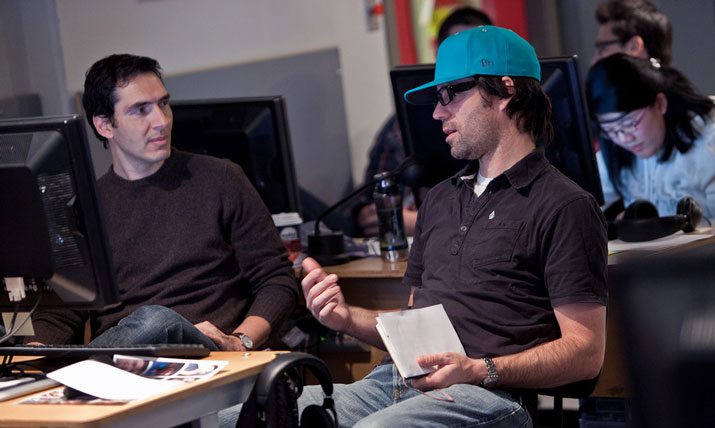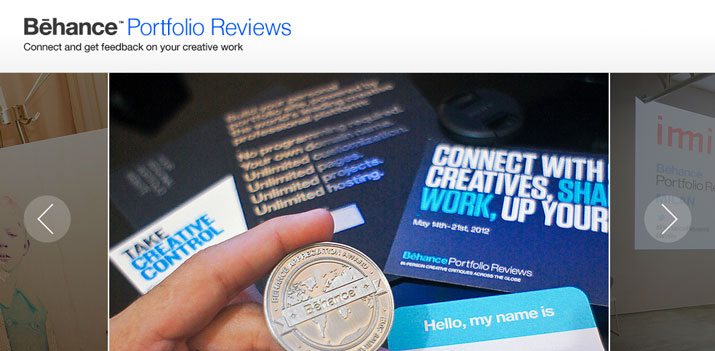Tips and Advice for a Design Portfolio Review
For every member of the design community – designers, photographers and illustrators – the portfolio is an essential tool when it comes to getting new clients or changing jobs.
The portfolio review can be one of the more stressful parts of your career. It can be tough to take criticism and hear things you may not want to about your work. A good portfolio review will make you better and it is just as important to understand how to receive a review as well as give a good one.
Why a Portfolio Review is Important

Portfolio reviews can take place at any point during your career. The first reviews are often early, as a student in the classroom setting, and continue throughout your career.
The portfolio review is a good tool for reflecting on your work. Picking out pieces to show in the portfolio is a good reminder of all you have learned and accomplished, while the review itself should help you grow as a designer. Reviews are typically designed to give you a fair appraisal of your work. While they often unofficially happen when courting a client or seeking new employment, portfolio reviews are best when they do not have other pretext.
Finally, feedback is the key to creative growth. If you are doing the same things you were five years ago, it will be reflected in your portfolio. The goal is to learn and grow as a creative worker.
Case Study 1: What Not to Do
As a young designer, I had a disastrous portfolio review. Granted, I was a little ill-prepared. My reviewer told me my work was just average. She pointed out all the techniques that were dated or trends of the past. She told me my typography pairings did not match and my color palettes were flat. (All of these things were true.)
But the problem, was that she did not offer me any solutions or tips for improving or even really explain why she was so very critical of my work.
But the problem, was that she did not offer me any solutions or tips for improving or even really explain why she was so very critical of my work. She did not provide me with any resources for learning. She also did not note a single thing from my portfolio that I had done well or that she liked. (What not to do for portfolio reviewers.)
Needless to say, I did not get a lot from the experience and left the meeting very discouraged. I almost considered forgetting design altogether because the review made me feel like a failure. While a portfolio review can be tough to stomach, you should always leave with some idea of where you are headed next and how to better yourself and your work.
Case Study 2: What Works
Later portfolio reviews helped me become a better reviewer too. My best portfolio review was short and simple. The reviewer examined 15 of my clips and gave me an overall synopsis of the work – she said it was clean, organized and easy to understand but lacked creative inspiration. While this may sound harsh it was true.
She explained that my technical work was great, but the examples lacked that “it factor.”
She then talked about ways to get there – a tweak to the typefaces, pops of color that were more unexpected, losing my attachment to perfect symmetry – and provided a stack of resources to help me. That was the day I became a true designer. It was a conversation that still inspires me today. And that is the perfect portfolio review.
Highlight the good and why it is working. Talk about the bad and offer suggestions for improvement. And make it a conversation.
I try to use things things I learned from my review when I work with others. The key is balance. Highlight the good and why it is working. Talk about the bad and offer suggestions for improvement. And make it a conversation. It is not easy for a designer to hear an outside opinion of projects he or she may be very close to (or proud of). And give yourself plenty of time to talk with the designer — a rushed review can lave both parties feeling unsettled.
Example Review

Let’s take a look at the image above and think about how it might be reviewed. Here are a few points the review might try to make:
- “Great job here showcasing different fonts for a project about lettering. The examples are clear and read well. Plus your overall headline is easy to read with the image. But how do you feel about the color choices? They feel a little “safe” to me. Did you look at something with more saturation?
- “Let’s talk about the type in the background. See how the letters don’t quite, but almost, line up from one panel to the next? The type would have worked better and created less visual chaos if if were all aligned to the same baseline, or were completely off balance with sizing that was not close at all.
- “Finally, think about the content and the visuals. You want them to match as much as possible. The big words talk about alternate lettering. The background panels should be more representative of that.
- Overall, your design is simple and organized well. If you were going to try this again, look closer at the details and consider jumping outside your comfort zone when it comes to color.”
Tips for Designers
- Put your portfolio together like a design project. It should be well-designed and organized. Be honest. As a designer, you need to be ready to show you work (10-15 pieces is normal).
- Organize your portfolio with intent. I always put my favorite (and best) pieces at the front and back of the portfolio, with my least favorites in the middle. Make a good first and final impression.
- Present the portfolio for review in the same way your would present it to a client or future employer. Have a print and digital version. Many reviews are done online and via tablets.
- Don’t argue. Accept communication openly, even if you may not agree with it.
- If you are being reviewed, make notes so you will remember information later. And create a great leave behind with your contact information for the reviewer.
- Get reviewed often and review the portfolios of younger designers as well. I like to talk about my work annually. I also try to give one review a year. It keeps you involved in the community, up-to-date on trends and makes you better as a designer.
Tips for Reviewers

- Be honest. As a reviewer, you must be able to address both the good and bad in a portfolio in a straightforward manner.
- Highlight things that work and things that need improvement. Explain why a technique is not working well and offer suggestions to improve it.
- Don’t argue. The review is designed for a designer to get an honest evaluation of his or her work. Don’t get into an argument about techniques or theory.
- Understand the level of the portfolio you are reviewing. Is it from a student, mid-level career designer or someone with years in the business? Tailor your comments to that person.
- Provide resources. If you are reviewing a portfolio that does not use color well, give the person a reading list, online community or training information.
- Get reviewed. Being reviewed regularly is the best way to stay fresh and maintain perspective on the review process.
Join a Portfolio Review

Get involved in a portfolio review. You can make arrangements personally or join a national group.
Portfolio networking sites such as Behance and Dribbble are great for connecting you with other members of the design community and helping to partner with someone for feedback. You can get feedback on your portfolio 24 hours a day, 7 days a week online or join live groups in various communities all over the world. (A combination of online and live portfolio reviews can be a fantastic resource and experience.)
Find and join a Dribbble meetup near where you live. Behance is sponsoring in-person portfolio reviews May 13-20, 2013, in locations worldwide.
Design Shack also has a community made up of designers and creatives, where you can rate and save designs for an unofficial, quick review. Learn more about membership.
Conclusion
As designers, we need to take part in portfolio reviews to grow and evolve. And we need to help other designers by providing honest feedback in the review process.
While the process can be painful, it does not have to be. With honest, straightforward and open communication, designers and reviewers can share and critique work in a positive environment. Remember to be aware of each others’ feelings and offer advice for improvement as well as complimenting work that deserves appreciation.
Image Sources: kodamapixel, VFS Digital Design and scuolafotografia.